Olfactory bulb mitral-tufted cell plasticity: odorant-specific tuning reflects previous odorant exposure
- PMID: 12890789
- PMCID: PMC2367229
- DOI: 10.1523/JNEUROSCI.23-17-06946.2003
Olfactory bulb mitral-tufted cell plasticity: odorant-specific tuning reflects previous odorant exposure
Abstract
Olfactory system second-order neurons, mitral-tufted cells, have odorant receptive fields (ORFs) (molecular receptive ranges in odorant space for carbon chain length in organic odorant molecules). This study quantified several dimensions of these excitatory odorant receptive fields to novel odorants in rats and then examined the effects of passive odorant exposure on the shape of the ORF-tuning curve. ORFs for carbon chain length of novel ethyl esters (pure odorants that the animals had not been exposed to previously) were determined before and after a 50 sec prolonged exposure to one of the odorants. In response to novel odorants, quantitative analysis of mitral-tufted cell excitatory ORFs revealed that the median ORF width spanned 3-4 carbons, generally with a single-most excitatory odorant. Exposure to either the most excitatory odorant (ON-PEAK) or an odorant that was two carbons longer (OFF-PEAK) for 50 sec produced whole ORF suppression immediately after the end of the prolonged exposure, with the ON-PEAK exposure producing the greatest suppression. These results are consistent with a feature-detecting function for mitral-tufted cells. Redetermination of the ORF 15 and 60 min after the exposure revealed that OFF-PEAK exposure produced a reduction in responsiveness to the best odorant and an increase in responsiveness to the exposed odorant. In contrast, exposure to the ON-PEAK odorant or no odorant did not affect ORFs. Given that mitral-tufted cells receive exclusive excitatory input from olfactory receptor neurons expressing identical receptor proteins, it is hypothesized that experience-induced mitral-tufted cell ORF changes reflect modulation of lateral and centrifugal olfactory bulb circuits.
Figures



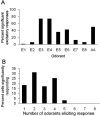

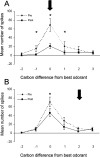
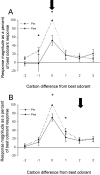

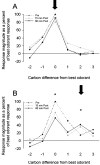

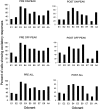

Similar articles
-
Comparison of odor receptive field plasticity in the rat olfactory bulb and anterior piriform cortex.J Neurophysiol. 2000 Dec;84(6):3036-42. doi: 10.1152/jn.2000.84.6.3036. J Neurophysiol. 2000. PMID: 11110830
-
Mitral and tufted cells differ in the decoding manner of odor maps in the rat olfactory bulb.J Neurophysiol. 2004 Jun;91(6):2532-40. doi: 10.1152/jn.01266.2003. Epub 2004 Feb 11. J Neurophysiol. 2004. PMID: 14960563
-
Odor response properties of neighboring mitral/tufted cells in the rat olfactory bulb.Neuroscience. 2005;134(3):1069-80. doi: 10.1016/j.neuroscience.2005.04.027. Neuroscience. 2005. PMID: 15994017
-
Emerging principles of molecular signal processing by mitral/tufted cells in the olfactory bulb.Semin Cell Biol. 1994 Feb;5(1):65-74. doi: 10.1006/scel.1994.1009. Semin Cell Biol. 1994. PMID: 8186397 Review.
-
Receptive fields in the rat piriform cortex.Chem Senses. 2001 Jun;26(5):577-84. doi: 10.1093/chemse/26.5.577. Chem Senses. 2001. PMID: 11418503 Review.
Cited by
-
Neural computations with mammalian infochemicals.J Chem Ecol. 2008 Jul;34(7):928-42. doi: 10.1007/s10886-008-9483-6. Epub 2008 Jun 14. J Chem Ecol. 2008. PMID: 18553119 Review.
-
Changes in Olfactory Sensory Neuron Physiology and Olfactory Perceptual Learning After Odorant Exposure in Adult Mice.Chem Senses. 2016 Feb;41(2):123-33. doi: 10.1093/chemse/bjv065. Epub 2015 Oct 28. Chem Senses. 2016. PMID: 26514410 Free PMC article.
-
Odor Experience Facilitates Sparse Representations of New Odors in a Large-Scale Olfactory Bulb Model.Front Neuroanat. 2016 Feb 11;10:10. doi: 10.3389/fnana.2016.00010. eCollection 2016. Front Neuroanat. 2016. PMID: 26903819 Free PMC article.
-
Physical Interaction Is Required in Social Buffering Induced by a Familiar Conspecific.Sci Rep. 2016 Dec 23;6:39788. doi: 10.1038/srep39788. Sci Rep. 2016. PMID: 28008991 Free PMC article.
-
Differential regional expression of brain-derived neurotrophic factor following olfactory fear learning.Learn Mem. 2007 Dec 17;14(12):816-20. doi: 10.1101/lm.781507. Print 2007 Dec. Learn Mem. 2007. PMID: 18086824 Free PMC article.
References
-
- Araneda RC, Kini AD, Firestein S ( 2000) The molecular receptive range of an odorant receptor. Nat Neurosci 3: 1248-1255. - PubMed
-
- Aroniadou-Anderjaska V, Ennis M, Shipley MT ( 1999) Dendrodendritic recurrent excitation in mitral-tufted cells of the rat olfactory bulb. J Neurosci 82: 489-494. - PubMed
-
- Brennan PA, Keverne EB ( 1997) Neural mechanisms of mammalian olfactory learning. Prog Neurobiol 51: 457-481. - PubMed
-
- Buonomano DV, Merzenich MM ( 1998) Cortical plasticity: from synapses to maps. Annu Rev Neurosci 21: 149-186. - PubMed
Publication types
MeSH terms
Substances
Grants and funding
LinkOut - more resources
Full Text Sources
Medical
Miscellaneous
